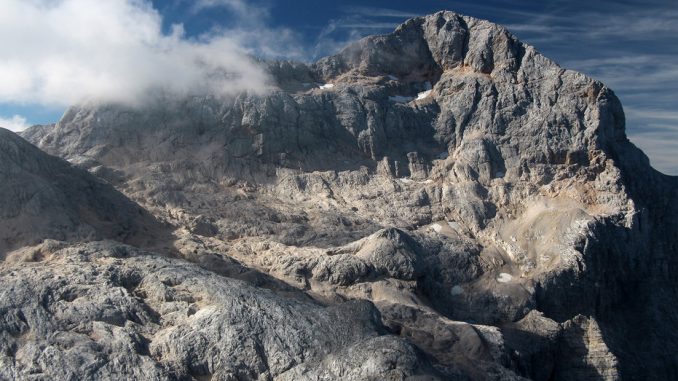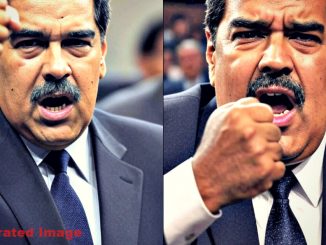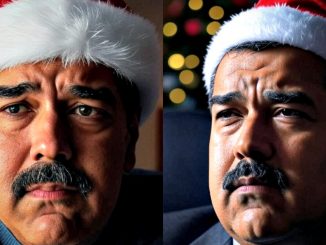
Triglav in Slovenia in 2023. The mountain was once home to a glacier, but only two volleyball courts’ worth of ice remain. Miha Pavšek, ZRC SAZU archive, Anton Melik Geographical Institute
| Published September 7, 2025
What to Question, What’s Solid
1. Claim: Venezuela is the first country in modern history to lose all its glaciers.
Supporters of this claim point to the Humboldt Glacier—also called La Corona—which has now shrunk so much that scientists no longer classify it as a glacier, but merely as an ice patch. This reclassification means Venezuela has gone from having six glaciers in the Andes a century ago to none today, making it the first nation in today’s records to lose them all.
However, the phrase “first country in modern history” deserves closer examination. The term “modern history” is vague and depends on definitions. For instance, some glaciologists argue that Slovenia lost its last glaciers decades earlier, raising questions about whether Venezuela is truly the “first.” Furthermore, what qualifies as a glacier is itself debated—many scientists use a minimum size threshold (0.1 square kilometers), but not all follow the same standard. This makes the claim more symbolic than absolute, hinging more on classification than on an undisputed scientific milestone.
Supported evidence:
-
The BBC confirmed that Venezuela’s last glacier, the Humboldt or La Corona, was downgraded to an ice field because it’s “too small to be classed as a glacier”
-
The Guardian reported that this glacier had shrunk to less than 2 hectares and that five others had already disappeared by 2011, making Venezuela the first modern country to lose all glaciers.
Points to highlight:
-
The term “first in modern history” is accurate—but how is “modern” defined? Scientists generally mean the period with reliable measurements and monitoring (20th–21st centuries).
-
Ensure distinction from historical periods such as Ice Age dynamics.
2. Scientific Credibility and Source Reliability
The report that Venezuela has lost all its glaciers primarily comes from the International Cryosphere Climate Initiative (ICCI), which announced the downgrade of the Humboldt Glacier on social media. While ICCI is staffed by respected scientists, it is also an advocacy organization dedicated to climate policy influence, not a neutral government or purely academic institution. This naturally raises questions about how much of the framing is science and how much is messaging.
Independent experts, such as glaciologists interviewed by the BBC and The Guardian, supported the reclassification, but the evidence has not yet been widely published in peer-reviewed journals. Instead, most outlets are recycling the ICCI’s statement, which can create an echo chamber effect where the claim spreads faster than it is rigorously tested.
Another point to consider is the definition of a glacier. Some scientists require active movement of ice; others rely on a minimum surface area (commonly 0.1 square kilometers). By those standards, Venezuela’s glacier may have been “lost” years ago. Moreover, as Scientific American noted, countries like Slovenia likely lost all their glaciers earlier, but were not given the same media spotlight.
Thus, while the downgrade is scientifically plausible, the way it was presented—through social media announcements and repeated by international headlines—means the credibility rests less on fresh peer-reviewed evidence and more on the authority of a single climate organization. This doesn’t make the claim false, but it does suggest we should treat it as scientific reporting filtered through advocacy rather than the final word.
Source:
The International Cryosphere Climate Initiative (ICCI) made the official downgrade on social media (X/Twitter), which then became widely cited
Points to probe:
-
ICCI is a scientific advocacy organization—not a government body. How closely have independent glaciologists verified these findings?
-
Statements from glaciologists like Caroline Clason lend support
3. Scope and Context
At first glance, Venezuela’s loss of its last glacier sounds like a global catastrophe, but in context, it is more of a localized event with symbolic weight than a practical disaster. Unlike countries such as Peru, Bolivia, or Colombia, Venezuela never had large glaciers to begin with. Its six glaciers, clustered in the Andes, were relatively small compared to the massive ice fields that sustain rivers and hydroelectric dams elsewhere in South America.
For instance, Peru still retains over 1,000 glaciers, even after losing more than half of its glacial mass in the last 60 years. These ice fields are critical to irrigation, drinking water, and energy production, meaning their retreat poses significant risks to millions of people. Venezuela’s glaciers, by contrast, were never a primary water source, and experts from the Washington Post noted that their disappearance has little direct impact on freshwater availability in the region.
This means that Venezuela’s “first to lose all glaciers” label is more symbolic than practical. It represents a milestone in the ongoing retreat of tropical glaciers, but does not signal an immediate humanitarian crisis. From a skeptical viewpoint, media headlines risk overselling the significance by treating Venezuela’s case as if it carries the same weight as Peru’s or the Himalayas’ glacial losses.
In reality, the broader context is that many nations are still decades away from reaching Venezuela’s point of complete glacier loss. Colombia, for example, is expected to lose its last glaciers within the next 30 years, but those glaciers currently still have measurable importance to local ecosystems and communities.
So, while Venezuela’s glacier loss is noteworthy in a scientific timeline, its practical impact is limited. The story should be framed as a warning sign of larger global trends, rather than an isolated disaster with sweeping consequences.
Broader Trends:
-
Peru, which hosts the majority of the world’s tropical glaciers, has lost 56% of its glacier coverage in the last six decades, though not all its glaciers
-
Peru remains vulnerable but retains significant glacial mass, unlike Venezuela.
What this suggests:
-
Venezuela’s complete loss is a dramatic, but localized, milestone—not yet a continental phenomenon.
-
Other Andean nations still have glaciers, although their retreat is accelerating.
4. Possible Overstatements or Missing Nuance
The framing of Venezuela’s glacier loss often leans toward dramatic, “end-of-the-world” style messaging, but several important nuances tend to get glossed over.
First, while it’s accurate that the Humboldt Glacier (La Corona) has been reclassified as an ice field, the practical consequences are far less severe than headlines imply. Unlike in Peru or Bolivia, where glaciers provide vital seasonal meltwater for agriculture, Venezuela’s small glaciers were never a key source of drinking water or irrigation. Reports from outlets like the Washington Post confirm that the loss will not significantly affect local rivers or hydropower. Presenting it as a looming crisis for Venezuelans oversells the situation.
Second, the definition of what counts as a glacier is not universally agreed upon. Some glaciologists use a minimum size threshold (0.1 km²), others emphasize ice movement. If one follows the stricter criteria, Venezuela’s glaciers may have technically “disappeared” years earlier. This means the 2024 reclassification is partly a matter of scientific semantics rather than a sudden collapse.
Third, the claim that Venezuela is the “first country in modern history” to lose its glaciers is itself debatable. Slovenia lost its last recognized glaciers decades ago, but did not receive the same global attention. This suggests that part of the narrative is shaped by media selectivity—choosing a case that resonates symbolically with the climate change storyline, rather than one that strictly holds the historical record.
Finally, some coverage implies that the event is a direct signal of global climate catastrophe, when in reality, Venezuela’s loss is a localized milestone within a broader global trend. The lesson here is not that Venezuela faces a unique crisis, but that small tropical glaciers are extremely vulnerable and will be among the first to disappear.
In short, while the event is scientifically noteworthy, its symbolism outweighs its actual local impact. A skeptical eye reminds us that clear definitions, historical context, and proportional reporting matter just as much as the headline itself.
-
The article claims the glacier “originally spanned a vast area” and now shrank to 2 hectares by 2019—this aligns broadly with other reports
-
References to threats to freshwater, irrigation, and hydroelectric surfaces—while generally valid—may oversell the immediate impact:
-
Washington Post noted that the glacier’s disappearance “will not have a direct impact on the fresh water capacity of nearby rivers”
-
So, while the emotional framing (“global wake-up call”) is compelling, it might overstate local consequences.
5. What to Watch Going Forward
-
Scientific follow-up: Are there peer-reviewed publications confirming the reclassification?
-
Geo-glaciological precision: What exactly defines the threshold between glacier and ice field? Could classification criteria change?
-
Wider lessons: Other nations—e.g., Colombia—are on track to lose their glaciers in the coming decades
Summary Table
| Point | Assessment |
|---|---|
| Loss of all glaciers in Venezuela | Well-supported by multiple credible sources |
| Local impact on water resources | Likely limited in immediate term—needs nuanced framing |
| Scientific rigor | Based on advocacy reports and experts; peer-reviewed studies would strengthen claim |
| Contextual relevance | Significant milestone—but not yet representative of all Andean countries |
🎥 What the Video Shows
The video walks viewers through the story of Venezuela’s last glacier, the Humboldt Glacier (also called La Corona), and how it shrank to the point of being reclassified as just an ice patch.
-
Historical Background
A century ago, Venezuela had six glaciers in the Andes. These glaciers were relatively small compared to those in Peru or Bolivia, but they were a unique feature of the country’s high-altitude landscape. The Humboldt Glacier was the last survivor after the others disappeared by the early 2010s. -
The Shrinking Process
The video highlights how the glacier steadily retreated through the 20th century and into the 21st. From an estimated 3 square kilometers in 1910, it shrank to less than 0.1 square kilometers by 2019, and by 2024 it had become so small it could no longer be classified as a true glacier. This isn’t a sudden collapse, but a long, gradual decline tracked by scientists and satellites. -
Reclassification as an Ice Field
Scientists explain that a glacier isn’t just “any ice on a mountain.” To count, it needs to move and cover a minimum surface area. Once the Humboldt got too small and lost its active movement, it was reclassified as an ice field instead. The video shows that this technical definition is key to why Venezuela is now considered glacier-free. -
Significance Framed in the Video
The disappearance is presented as a symbolic milestone: Venezuela becoming the “first country in modern history to lose all its glaciers.” The video stresses the global warning aspect—pointing out that if small glaciers can vanish here, larger glaciers elsewhere are also at risk. -
Subtle Skeptic Takeaway
While the video shows before-and-after visuals to emphasize the change, it doesn’t dwell much on the fact that Venezuela’s glaciers were small to begin with, nor that their disappearance has minimal local impact on water resources or agriculture. From a skeptical perspective, the video leans more on symbolism and emotional framing than on practical consequences.
“Venezuela used to have six glaciers high up in the Andes. The last one, called the Humboldt Glacier, has been melting for more than a century. By now, it’s so tiny that scientists say it’s no longer a glacier, just a patch of ice.
This makes Venezuela the first country in today’s world to completely lose all its glaciers. Now, the loss doesn’t mean Venezuela will run out of water—the glacier was too small to matter for rivers or farming—but it’s a powerful symbol of how fast tropical glaciers are vanishing.
So, the video is basically showing us a before-and-after story: how a once big chunk of ice shrank down to nothing, and what that says about climate change.”
 Overall Takeaway:
Overall Takeaway:
While it’s true that Venezuela has lost its last glacier, the Humboldt, we need to put this in perspective. The glacier was already very small, covering less than 2 hectares, and scientists admit its disappearance has little to no impact on local water supplies or agriculture. In other words, this is more of a symbolic milestone than a practical disaster.
Yes, it illustrates how warming affects high-altitude ice, especially in the tropics—but the way headlines frame it as a “wake-up call” may exaggerate its global importance. Larger glaciers in Peru, Bolivia, and the Himalayas matter far more for people’s survival and ecosystems.
So, the real takeaway isn’t that Venezuela is facing a glacier crisis, but that we should separate scientific facts from media spin. Venezuela’s loss is noteworthy, but it’s not the dramatic catastrophe some coverage makes it sound like.





Be the first to comment